The Western Digital Blue (1TB) SSD Review: WD Returns to SSDs
by Billy Tallis on October 11, 2016 8:00 AM EST- Posted in
- SSDs
- Storage
- Western Digital
- SanDisk
Sequential Read Performance
The sequential read test requests 128kB blocks and tests queue depths ranging from 1 to 32. The queue depth is doubled every three minutes, for a total test duration of 18 minutes. The test spans the entire drive, and the drive is filled before the test begins. The primary score we report is an average of performances at queue depths 1, 2 and 4, as client usage typically consists mostly of low queue depth operations.
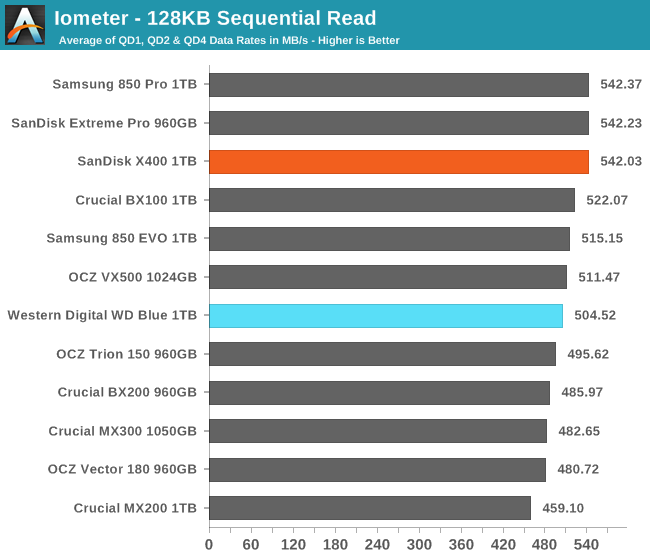
While the SanDisk X400 tied the best MLC SSDs for sequential read speed, the WD Blue is merely average overall.
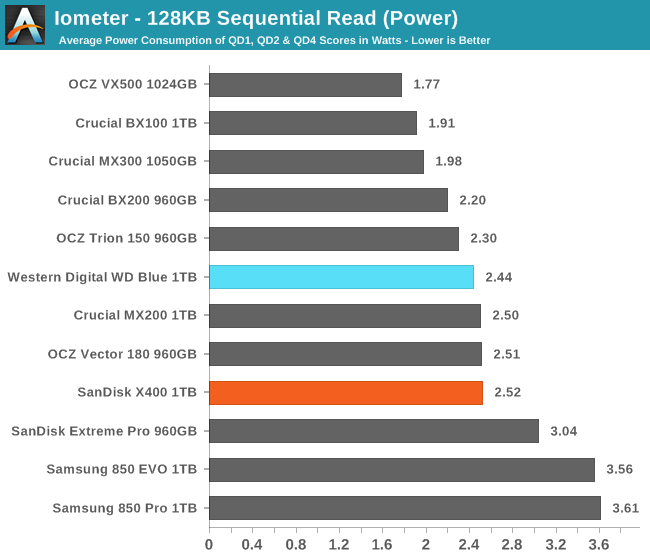
The WD Blue draws slightly less power than the X400, but given the size of the performance regression the WD Blue is actually less efficient for once.
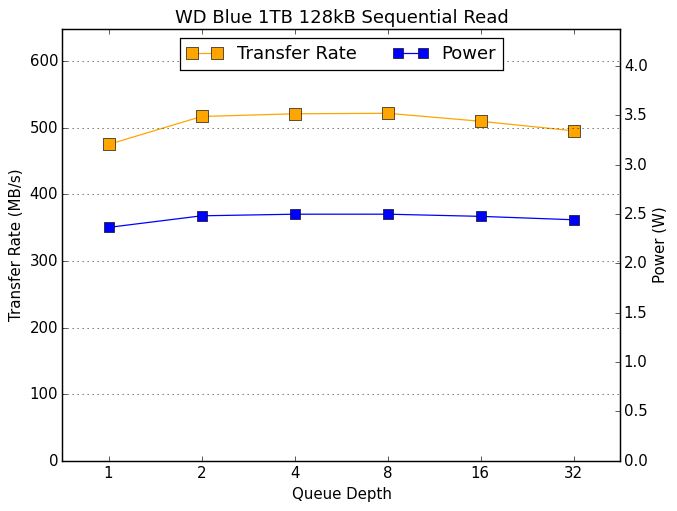 |
|||||||||
The WD Blue seems to hit a performance plateau that is a bit shy of saturating the SATA link, and then it slows down at the highest queue depths.
Sequential Write Performance
The sequential write test writes 128kB blocks and tests queue depths ranging from 1 to 32. The queue depth is doubled every three minutes, for a total test duration of 18 minutes. The test spans the entire drive, and the drive is filled before the test begins. The primary score we report is an average of performances at queue depths 1, 2 and 4, as client usage typically consists mostly of low queue depth operations.
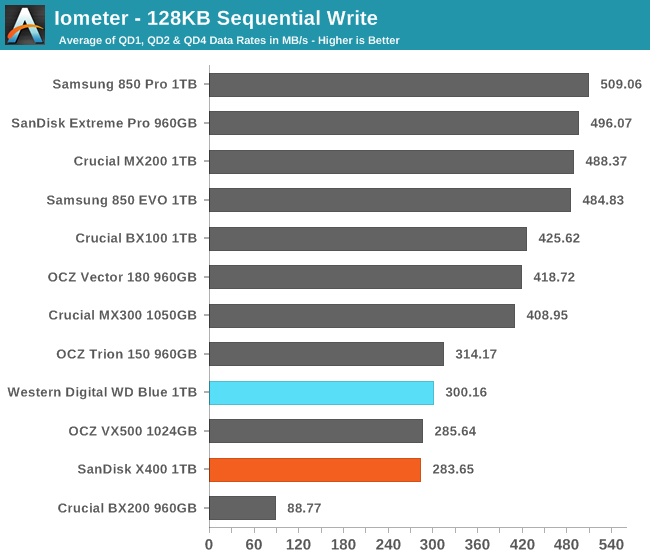
The WD Blue has a faster sequential write speed than the X400, but doesn't quite catch up to the OCZ Trion 150. Most MLC and 3D TLC drives are significantly faster than the planar TLC drives.
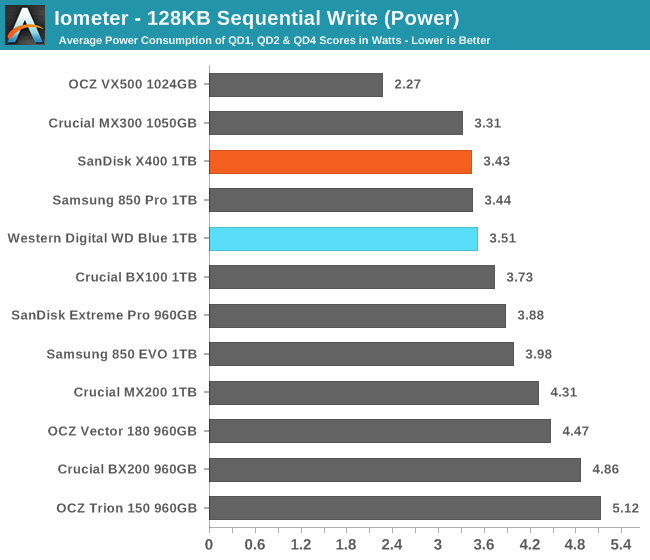
The WD Blue draws more power than the SanDisk X400 during the sequential write test, but it is justified by the improved performance. Efficiency is still only good by planar TLC standards.
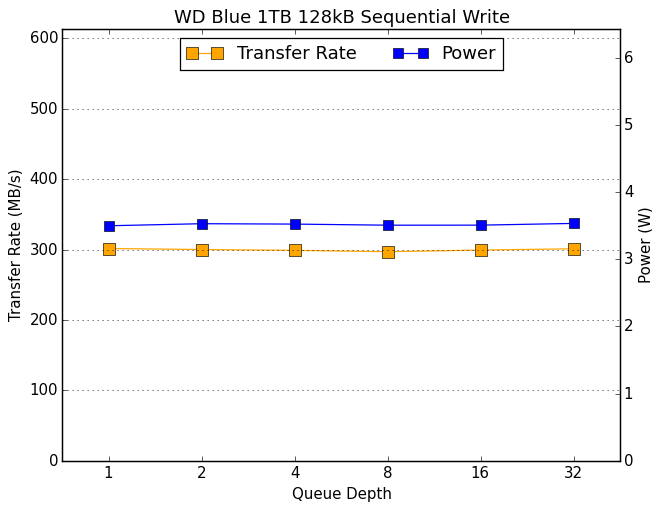 |
|||||||||
The WD Blue's sequential read speed is constant across all queue depths, without even an increase from QD1 to QD2.










75 Comments
View All Comments
Magichands8 - Wednesday, October 12, 2016 - link
That's funny you should say that since I've been noticing it for years. Every single time I move around large files to reorganize or back them up, in fact. But I'm sure that I'm the only non-video editing person on the planet who doesn't use his computer exclusively for reading and writing tiny text files and browsing the internet. I'm also sure that I'm the only who would have a problem paying a premium for very low capacity devices just so I could experience their limitations.Michael Bay - Thursday, October 13, 2016 - link
Oy vey, nobody in the market cares for my special snowflake wants, it`s anudda shoah!mapesdhs - Friday, October 14, 2016 - link
You need more explosions in your posts. ;Dbeginner99 - Wednesday, October 12, 2016 - link
It's cheap but not really excitingly cheap. Doesn't really beat the aged MX200 which also comes with MLC NAND which I deem superior to this TLC low-end crap. Only advantage this has over MX200 is price. Good for a cheapo game-drive maybe but would avoid as OS drive.Arnulf - Wednesday, October 12, 2016 - link
Ewww, 15nm planar TLC along with WD branding.JimmiG - Wednesday, October 12, 2016 - link
I remember the time when the 850 Evo was considered a "budget" SSD. Now it's almost a high-end SSD.haukionkannel - Wednesday, October 12, 2016 - link
And the price of evo is still going up. Hopefully there will be stop to it eventually.Impulses - Wednesday, October 12, 2016 - link
It's not really going up, just plateau'ing hard, sales might be happening slightly less frequently lately, I dunno... I do remember seeing the 1TB under $300 a number of times but it's mostly been just over $300 for well over a year.I paid $320-ish for two back in July-August 2015 when they were first starting to get close to $300. It's still faster than the field and brand alone is probably sustaining their ability to charge a premium.
mapesdhs - Friday, October 14, 2016 - link
Maybe it depends on where you live, but the 850 EVO went up a lot where I am (UK). Back in Jan this year the 250GB was 53 UKP, now the same model is 85 UKP. Samsung is exploiting demand for what used to be a well priced, reliable product to give the model a premium image that's pushing its cost far above where it really should be. This has happened before, eg. when the 830 series shot up in early 2013 after strong demand, which helped ensure all other brands didn't lower their prices.TheinsanegamerN - Friday, October 14, 2016 - link
what HASNT shot up in price in the UK post-Brexit vote?